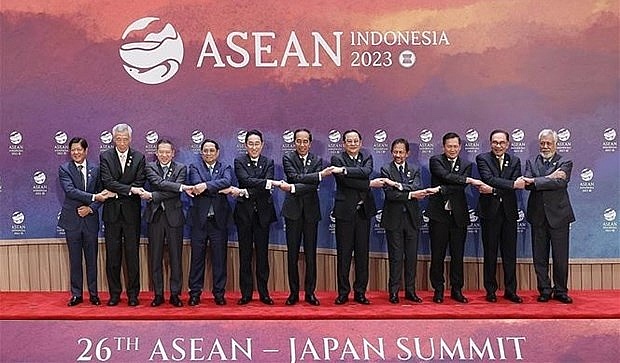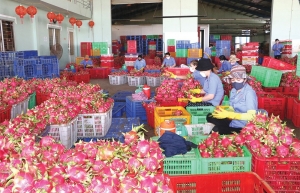ASEAN-China ties taking crucial steps
According to Vietnam’s Ministry of Foreign Affairs, Prime Minister Pham Minh Chinh and a high-level delegation flew to China to attend the 20th China-ASEAN Expo (CAEXPO) on September 16-17 at the Nanning International Convention and Exhibition Centre in Guangxi province.
 |
| ASEAN-China ties taking crucial steps, photo VNA |
The PM will also attend the 20th China-ASEAN Business and Investment Summit.
The expo serves as a high-level dialogue platform for friendly exchanges and the enhancement of political mutual trust between China and ASEAN leaders, which provides long-term and stable political support for friendly cooperation.
“Through speeches at the opening ceremonies, bilateral and multilateral meetings, and commemorative activities, leaders from both sides continually strengthen their common will, coordinate joint actions, and promote cooperation from consensus to practice,” the China-ASEAN Expo Secretariat said. “This has led to the elevation of relations from a strategic partnership to a comprehensive strategic partnership, and the upgrading of the China-ASEAN Free Trade Area (ACFTA) has provided strong evidence.”
Vietnam considers the expo a big opportunity to promote its goods and services and draw in more investment from these economies.
During their bilateral meeting in Beijing in June, Chinese Premier Li Qiang told PM Chinh that China would further open its market for Vietnamese goods, especially high-quality agricultural and aquatic products and fruits.
China will also coordinate in creating better conditions for quarantine and customs clearance, and stand ready to work together with Vietnam to address obstacles related to institutions and policies.
PM Qiang also suggested the two countries strengthen strategic connectivity, particularly in infrastructure and transport; promote cooperation in economy, trade, and investment in the sectors of production, manufacturing, and agriculture; as well as boosting cooperation in fostering supply and production chains.
The Chinese government encourages Chinese companies and groups, especially major ones with advanced technology, to expand investment in Vietnam in line with its demand and sustainable development strategy.
Currently, the top exports of China to Vietnam are integrated circuits, mobile phones, sound recorders, electric batteries, and knitted or crocheted fabrics.
Meanwhile, key imports of China from Vietnam include agricultural products, integrated circuits, broadcasting accessories, office machine parts, and non-retail pure cotton yarn.
PM Chinh in June also met with leaders of major Chinese groups including Texhong International Group, Runergy, Energy China, Goertek, and TCL, among others. They said that their groups would expand operations in Vietnam.
For example, chairman of the Board of Texhong International Group Hong Tianzhu said it is seeking new opportunities in Vietnam’s textile and garment sector.
Texhong has invested over $1.6 billion in Vietnam since 2006, establishing 12 textile and apparel projects in Dong Nai, Quang Ninh, and Thai Binh provinces, creating employment opportunities for over 25,000 workers.
Additionally, in Quang Ninh, Texhong has established a textile industrial park to service a vertically integrated textile supply chain.
Bilateral trade between Vietnam and China hit $175.6 billion last year, accounting for approximately 24 per cent of Vietnam’s total import-export turnover. In the first eight months of this year, the figure reached $103 billion, with Vietnam’s exports to China hitting $35.8 billion, up 0.1 per cent on-year, and imports from China reaching $68.1 billion, down 17 per cent on-year.
According to the Vietnamese Ministry of Planning and Investment, as of August 20, Vietnam had about 3,950 Chinese valid ventures registered at $25.8 billion, making China its sixth-largest foreign investor. In the January-August period, China ranked second in Vietnam’s list of foreign investors, with total new capital of $2.7 billion.
Currently, ministers from ASEAN member states and China are boosting negotiations of a new version of the ACFTA. The first round of negotiations began in April.
According to the ASEAN Secretariat, the upgrade will focus on sectors that benefit the interests of both ASEAN and China. They include the digital economy, green economy, non-tariff measures, consumer protection issues, and micro, small, and medium-sized enterprises, as well as the rearrangement of chapter structure of the agreement.
“We expect the ACFTA 3.0 to better benefit the people of both sides. At present, more than 90 per cent of commodities (about 7,000 types) already enjoy zero tariff treatment between China and ASEAN, effectively enhancing business efficiency, social employment and people’s income,” said Hou Yanqi, the Chinese Ambassador to ASEAN.
The update will further reduce tariffs, regulate measures customs, inspection, and quarantine, and enhance trade liberalisation. “It will also better protect the rights and interests of consumers on both sides, promote the development of micro, small, and medium-sized enterprises, and create more jobs,” Yanqi said.
 | ASEAN, US partners launch ASEAN SME Academy 2.0 The Association of Southeast Asian Nations (ASEAN) in collaboration with the US-ASEAN Business Council (US-ABC) and the US Agency for International Development (USAID) on April 8 officially launched the ASEAN SME Academy 2.0, an upgraded version of an online learning platform. |
 | China-ASEAN trade to get fresh booster An upgrade of the ASEAN-China free trade deal and positive impacts from the Regional Comprehensive Economic Partnership are set to benefit Vietnam-China trade ties. |
What the stars mean:
★ Poor ★ ★ Promising ★★★ Good ★★★★ Very good ★★★★★ Exceptional
 Tag:
Tag:
Related Contents
Latest News
More News
- 72 nations sign landmark Hanoi cybercrime convention (October 26, 2025 | 18:00)
- UN Secretary-General commends Vietnam’s global leadership (October 26, 2025 | 09:00)
- APEC finance ministers convene to tackle regional challenges (October 22, 2025 | 17:31)
- Rewiring global trade: ASEAN’s rise as supply chain hub (October 17, 2025 | 11:40)
- Vietnam attends first World Nuclear Week Forum in Russia (September 26, 2025 | 10:50)
- Vietnam attends 69th session of IAEA General Conference (September 16, 2025 | 10:00)
- ADB, WB pledge over 12 billion USD for ASEAN power grid, renewable energy projects (August 15, 2025 | 14:18)
- Lowy Institute proposes AI-based tobacco control solutions for ASEAN (August 15, 2025 | 14:14)
- Cloud computing policy to position Malaysia as regional hub by 2030 (August 15, 2025 | 14:11)
- Thailand, Cambodia suffer numerous cyber attacks (August 05, 2025 | 16:19)























 Mobile Version
Mobile Version